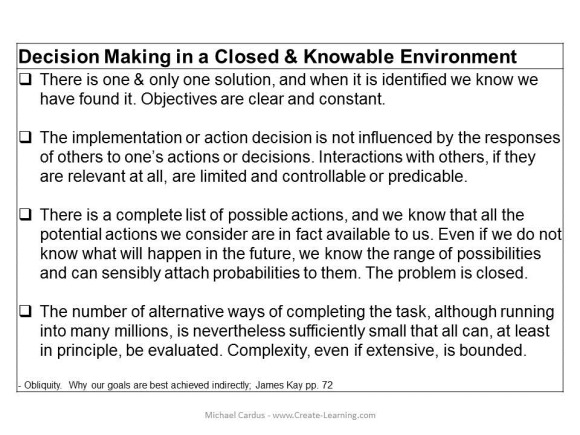“If you are clear about your high-level goals and knowledgeable enough about the systems their achievement depends on, then you can solve problems in a direct way. But goals are often vague, interactions unpredictable, complexity extensive, problem descriptions incomplete, the environment uncertain. That is where obliquity comes into play.” – John Kay, Obliquity pg 194
There are times I feel that I’m getting closer to understanding how organizations work & people interact within them… The closer I think I am the more I’m not seeing. What I’m not seeing causes distrust that someone is hiding something. This distrust changes how I work, changing how the client works with me.
Then I stop staring at my whiteboard & acknowledge that I am using linear thinking.
Linear Thinking: a process of thought following known cycles or step-by-step progression where a response to a step must be elicited before another step is taken
Most team building & organization development work is too interactive to be linear. 
This thinking (and staring) brings me to loose framed models of working through a cross-functional team that impacts almost every part of the organization + parts outside the organization, i.e., customers, vendors, communities, and politicians.

As I loosen the idea that I/we have access to direct cause & effect, in a Humian sense, we have constant conjunction. Oblique – non-direct – understanding gives me some comfort.
The belief that we can control, with certainty, the outcomes from defined goals leads to disappointment when the expectation does not match up to reality. This disappointment causes stress. Trust-repelling behaviors infiltrate work systems. These trust-repelling systems change peoples’ behavior.
The solution? I’m not sure. That is OK.
I don’t think it is to eliminate goals or structure to create a nihilistic organization. Even a nihilistic organization will self-form a hierarchy to accomplish shared work.
What works well for me is to go to a heuristic process that slows me down & creates a small experiment or next step to take. I can see what worked to increase plus what-didn’t-work to decrease. Distinctive Working Well 100 Days Better ..
Working through this process with the client creates a shared language of progress/regress & we can accept some of the ambiguity & conjunction within the team.

